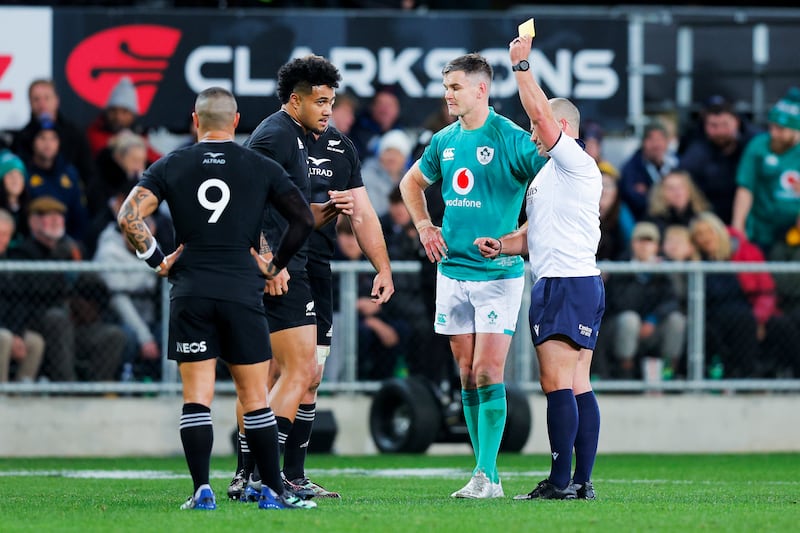Referee Jaco Peyper and his officiating team struck several discordant notes from an Irish perspective during the 23-12 victory over New Zealand at the Forsyth Barr stadium and it will be interesting to see if World Rugby call the match officials to account.
If that proves to be the case, it would constitute the second time in a week that rugby’s global governing body would be forced to concede that the Ireland team has been the victim of incorrect officiating.
Following World Rugby’s review of the first Test, it has been reported that Ireland received clarification on several contentious issues in that defeat including the acknowledgment that All Blacks Scott Barrett and Rieko Ioane committed yellow card offences and that Joey Carbery ought to have been awarded a penalty try.
On Saturday, the first incident of note involves New Zealand wing Leicester Fainga’anuku who jumped into Mack Hansen and caught the Irish player with his shoulder to the face. English television match official, Tom Foley encouraged Peyper to stop the match 30 seconds later and review the incident.
READ MORE
Foley said: “I am about to show you that the follow through from the attempted charge down, he (Leicester Fainga’anuku) misses the opportunity to go for the ball and makes contact with his shoulder. He is never targeting the ball. His arm is hitting his chest but there is contact (to the face).”
Peyper responded: “The first contact is on the chest but there is also contact to the head after that. We are looking at a level of danger of a yellow card.” Foley responded: “I agree it is not high danger, it is yellow card.” It is a head scratching assessment from both officials.

Fainga’anuku weighs 17 stone, two pounds, he is more than a second late, has no chance of charging down the ball, is airborne and tucks his elbow in, brushes Hansen’s chest briefly with his forearm before making principal contact with a shoulder to the face.
As an action, it’s dangerous, reckless and it’s a red card. Or does the recipient have to end up with broken bones or a severe concussion for it to warrant a red card? Answer on a postcard to World Rugby.
The next controversy is when New Zealand tighthead prop, Ofa Tu’ungafasi tackles Garry Ringrose off the ball when the Irish centre is about to receive a try scoring pass from Jonathan Sexton, eight metres from the New Zealand line. Play continued but Foley alerted the South African referee to the foul play.
Peyper reviewed the footage and said: “It’s a tackle off the ball by New Zealand black three; It looks like there is cover from 15. You have nine tracking back and 13 (it should be 15) working back. It is a line-break opportunity but we are not ... there is cover.” Johnny Sexton queries the decision, but the referee responded: “We have looked at the cover and we are all right (with our adjudication).”
New Zealand scrumhalf Aaron Smith was part of the tackle on Sexton so he was out of the game, Ringrose, without Tu’ungafasi’s illegal intervention will receive the ball metres from the All Blacks’ line with no one in front and a two-metre start on Jordie Barrett.
It is possibly the only time in rugby’s history that “the cover” is behind the player who has been impeded so close to the try line. Tu’ungafasi received a yellow card with Ireland awarded a penalty. Six minutes later, replacement prop Angus Ta’avao is upright and accelerating into contact when he is undone by Ringrose’s footwork, catching the Irish centre in the face/head with his head.
Peyper initially suggested: “We have got an accident. I think that is a direction change I don’t think there is anything foul (play about it).” Foley literally has a word in the referee’s ear which prompted a change to Peyper’s tune. He said: “Tom (Foley), he’s upright, he steps into him, it’s direct head contact. Agreed, I don’t see the change of direction, he actually accelerated into him. So, it’s a red card.”
The officials get that one right but on 32 minutes and 36 seconds, Ireland win a penalty and Sexton cleverly opts for a scrum. With tighthead prop Tuungafasi (yellow card) and his replacement Ta’avao (red card) off the field at the same time, a loosehead prop Aidan Ross is introduced but it necessitated uncontested scrums for a brief period.
During that time New Zealand should have been reduced to 12 players under the laws — you lose an additional player as the team responsible for the uncontested scrums — mimicking a similar scenario in Ireland’s victory over Italy in a Six Nations match earlier this year.
Peyper and his officiating team did not twig the transgression, albeit that it only lasted a few minutes until Tuungafasi returned from the sin bin. It was nevertheless a serious blooper.
There is no doubt that winning will have softened any Irish disquiet but they’d like to think that they won’t suffer the rough edge of the officiating for a third time next Saturday in Wellington.
















